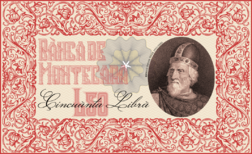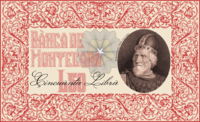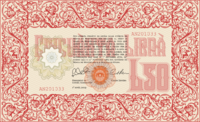Montecaran libra
| Montecaran libra | |
|---|---|
| libra Montecarà (Montecaran) | |
 A currently issued 50-libra note | |
| ISO 4217 | |
| Code | MCL |
| Denominations | |
| Subunit | |
| 1/12 1/100 | ònçia (historic) çèntima (electronic only) |
| Plural | librà |
| ònçia (historic) çèntima (electronic only) | onçià çentimà |
| Symbol | Ł |
| ònçia (historic) çèntima (electronic only) | ø ℂ (rarely) |
| Banknotes | |
| Freq. used | Ł20, Ł50, Ł100, Ł200 |
| Rarely used | Ł500 |
| Coins | |
| Freq. used | Ł1, Ł2, Ł5, Ł10 |
| Demographics | |
| User(s) | |
| Issuance | |
| Central bank | Banca de Montecara |
| Website | banca.go.mc |
| Valuation | |
| Pegged with | Aininian louré (ANL) |
| Value | 1 ANL = 1.60 MCL |
The Montecaran libra is the official currency of Montecara, issued by the Bànca de Montecara. It is pegged to the value of the Aininian louré at the rate of 1 ANL to 1.60 MCL.
History
The libra is ultimately derived from the troy pound of silver that formed the basis of the monetary system in the Latin Republic. The name “libra” is in fact the Latin word for “pound.” From classical times to 1870, the libra was on the silver standard; between then and 1951, it was on a bimetallic gold and silver standard, where the price of gold was periodically readjusted to the price of silver. The convertibility of the libra to gold ended when the Aininian louré was taken off the gold standard; the Bànca de Montecara chose to adopt a fixed exchange rate to the louré rather than issuing the libra as fiat currency with a floating exchange rate.
Until 1982, the libra was subdivided into 12 onçià, though coins were last made in that denomination only in 1960. After decimalization, the libra was divided into 100 çentimà instead, though the unit exists for electronic transfers only and has never been produced in coin or bill form.
Exchange rate
The Bànca de Montecara, Montecara's central bank, sets the rate of exchange between the libra and the louré. It was last changed on 1 July 2002, when it was lowered from 1 ANL = 1.67 MCL to the current 1.60 MCL.
The Bànca has described a number of advantages that Montecara obtains from having a fixed exchange rate to the louré, including:
- Fiscal predictability thanks to a libra that is tied to a stable reserve currency
- The ability of the state to buy commodities on the international market at competitive prices
- Stable terms of trade with Montecara's most important trading partner
Economists have conversely noted that, because Montecara does not impost capital controls because of its important financial sector, the fixed exchange rate leaves it with little to no control over its monetary policy. Because of the fixed exchange rate, the Bànca must hold the equivalent value in louré to all libra in circulation. This means that Montecara is an aggressive purchaser of Aininian government debt, and that Aininian bonds form the bulk of the Bànca's foreign reserve portfolio.
Coins
| Image | Value | Description | |
|---|---|---|---|
| Obverse | Reverse | ||
| Ł1 | Denomination, bank mark, and year | Emblem of Cròxa, symbolizing the six sieteri of the old city | |
 |
Ł2 | Denomination, bank mark, and year | Wreath of coral and trident |
 |
Ł5 | Denomination, bank mark, and year | Scallop shell and waves |
 |
Ł10 | Denomination, bank mark, and year | Coat of arms of Montecara |
Banknotes
| Image | Value | Description | |||
|---|---|---|---|---|---|
| Front | Back | Dimensions (mm) | Front | Back | |
| Ł20 | 116 × 72 | Captain-General Càrle Xèno | Seascape with Montecaran galleys | ||

|

|
Ł50 | 135 × 82 | Painter Tixàn Vecèlo and his masterpiece Neptune Offers the Wealth of the Sea to Montecara | Apollo Pursuing Daphne by Tixàn Vecèlo |
| Ł100 | 165 × 106 | Architect Arnòld di Buçhe | Pànteon Nuova | ||
| Ł200 | 181 × 115 | Diplomat Mària Àgrite | Arc da Liberàxon | ||
| Ł500 | 200 × 125 | Explorer Enrico Dulio | Palaço Pùblico | ||